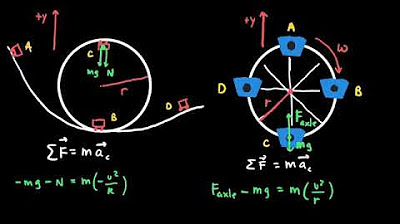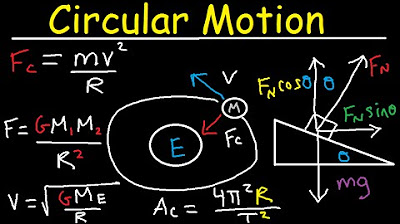2018 #1 Free Response Question - AP Physics 1 - Exam Solution
TLDRIn this engaging physics problem-solving session, students tackle a 2018 AP Physics 1 exam question about a spacecraft in circular orbit. They discuss the forces acting on the spacecraft, derive an equation for its orbital period, and explore the effects of changing the spacecraft's orbit radius on its speed. The session emphasizes the importance of accurate free-body diagrams and understanding gravitational forces, centripetal acceleration, and the relationship between linear and angular velocity in circular motion.
Takeaways
- 📚 The problem-solving session involves a 2018 AP Physics 1 exam question about a spacecraft in a circular orbit around Earth.
- 🚀 The spacecraft experiences only one force in space: gravity, which is directed towards the center of the Earth.
- 🎨 A Freebody diagram is essential for solving physics problems, and it should clearly represent the forces acting on the object of interest.
- 📝 For Part A of the question, the correct Freebody diagram earns 2 out of 7 points, emphasizing the importance of accurate diagramming.
- 🌌 The orbital period of a spacecraft is derived using the force of gravity and centripetal acceleration, with the formula involving the radius of the orbit and the mass of the Earth.
- 🔄 The mass of the spacecraft does not affect its orbital period, as demonstrated in Part B of the problem with two spacecraft of different masses.
- 📊 Understanding the relationship between orbital radius and speed is crucial; as the radius increases, the orbital speed decreases.
- 🤔 Angular velocity and linear (tangential) velocity are related, but the assumption that angular velocity remains constant with a changing radius is incorrect.
- 🌍 When discussing the speed of an object in circular motion, it typically refers to linear speed unless specified as angular speed.
- 💡 The concept of conservation of angular momentum explains why the angular velocity decreases with an increase in orbital radius.
- 📚 Even if a conclusion is incorrect, a logical and consistent explanation can earn points in problem-solving sections of exams.
Q & A
What is the primary force acting on the spacecraft in the given problem?
-The primary force acting on the spacecraft is the gravitational force from the Earth, directed towards the center of the Earth.
How does the wording of the question regarding the forces acting on the spacecraft potentially lead to confusion?
-The question asks to draw and label 'forces plural', which might imply there are multiple forces. However, there is only the gravitational force acting on the spacecraft in space, causing confusion about the requirement to label multiple forces.
What is the significance of the free-body diagram in physics problems like this one?
-A free-body diagram is crucial in physics as it represents all the forces acting on an object. It helps in visualizing the problem, applying Newton's laws, and solving for unknown quantities. In this problem, it is worth 2 out of 7 points, emphasizing its importance.
How does the mass of the spacecraft affect the orbital period according to the problem statement?
-The mass of the spacecraft does not affect the orbital period. The orbital period is derived from the equation that cancels out the mass of the spacecraft, indicating that the period is independent of the spacecraft's mass.
What is the relationship between the orbital radius and the orbital speed of a spacecraft?
-As the orbital radius increases, the orbital speed of the spacecraft decreases. This is because the gravitational force, which provides the necessary centripetal force for circular motion, is inversely proportional to the square of the radius according to Newton's law of gravitation.
How does the angular velocity of a spacecraft change when its orbital radius increases?
-When the orbital radius increases, the angular velocity of the spacecraft decreases. This is because the spacecraft's rotational inertia increases with the radius, and to conserve angular momentum, the angular velocity must decrease.
What is the correct way to represent the force of gravity in a free-body diagram for the spacecraft?
-The force of gravity should be represented by a single distinct arrow starting at the center of the spacecraft and pointing towards the center of the Earth. It is important to ensure that the force is correctly identified and that it starts from the correct point on the spacecraft.
What is the formula for the orbital period of a spacecraft in terms of the given variables?
-The orbital period (T) of a spacecraft can be calculated using the formula T = √((4π² * r³) / (G * M_e)), where r is the radius of the orbit, G is the universal gravitational constant, and M_e is the mass of the Earth.
Why is it important to only include forces or force components in a free-body diagram?
-Including only the relevant forces or their components in a free-body diagram ensures accuracy and clarity in problem-solving. Excessive or incorrect forces can lead to errors in applying Newton's laws and result in incorrect solutions.
What happens to the spacecraft's linear speed when it is moved to a larger orbit radius?
-When a spacecraft is moved to a larger orbit radius, its linear speed decreases. This is because the gravitational force, which provides the centripetal force, is weaker at larger radii, requiring less speed to maintain circular motion.
How does the concept of angular momentum conservation apply to a spacecraft moving to a larger orbit radius?
-The conservation of angular momentum dictates that if a spacecraft moves to a larger orbit radius, its rotational inertia increases, and to maintain the same amount of angular momentum, the angular velocity must decrease, which in turn reduces the linear speed.
Outlines
🚀 Solving AP Physics Exam Question - Spacecraft's Circular Orbit
The paragraph begins with a discussion about solving a question from the 2018 AP Physics 1 exam. The scenario involves a spacecraft in a clockwise circular orbit around Earth, and the task is to draw a Freebody diagram representing the forces acting on the spacecraft. The participants identify that the only force acting on the spacecraft is gravity, originating from the center of the spacecraft and pointing towards Earth's center. The importance of accurately drawing the Freebody diagram is emphasized for exam grading purposes. The discussion then moves to solving Part B of the problem, which involves deriving an equation for the spacecraft's orbital period using given variables such as the spacecraft's mass (M), Earth's mass (M_sub_e), the orbit's radius (R), and physical constants. The solution process is explained, highlighting the use of Newton's universal law of gravitation and the concept of centripetal acceleration. The equation for the orbital period is derived, and the participants correct a misconception regarding the force of gravity in space versus on a planet's surface.
🌌 Alternative Solutions and Grading Insights for the Spacecraft's Orbital Period
This paragraph continues the conversation about the spacecraft's orbital period, exploring alternative methods of solving the problem. The participants discuss the possibility of using the spacecraft's angular velocity instead of its tangential velocity to find the orbital period, which is confirmed as a valid approach. The conversation then shifts to grading guidelines, emphasizing the importance of not altering the Freebody diagram from Part A when solving the rest of the problem. The participants are reminded to express their answers in terms of the variables provided in the problem statement. A new question is introduced, comparing the orbital periods of two spacecraft with different masses but the same orbital radius, leading to the conclusion that the periods are equal since mass cancels out in the derived equation. The grading criteria are further clarified, allowing for partial credit as long as the reasoning aligns with the answer.
🪐 Correcting Misconceptions about Orbital Speed and Angular Velocity
The final paragraph addresses a common misconception about the relationship between a spacecraft's orbital speed and its angular velocity when the orbit's radius changes. The participants discuss a scenario where the spacecraft's orbit radius is increased and whether this would result in an increase or decrease in speed. Initially, an incorrect assumption is made about the constancy of angular velocity, which is later corrected by revisiting the relationship between orbital speed, radius, and angular velocity. It is explained that an increase in radius leads to a decrease in orbital speed due to the conservation of angular momentum. The angular velocity must decrease to maintain the same amount of angular momentum as the rotational inertia increases with the larger orbit radius. The discussion concludes with a clarification that the question refers to linear speed, not angular speed, and acknowledges that correctly arguing the problem using angular speed could also merit full credit for Part C.
Mindmap
Keywords
💡Circular Orbit
💡Freebody Diagram
💡Gravity
💡Centripetal Acceleration
💡Orbital Period
💡Newton's Universal Law of Gravitation
💡Tangential Velocity
💡Angular Velocity
💡Conservation of Angular Momentum
💡Gravitational Force
Highlights
The discussion revolves around solving response questions from the 2018 AP Physics 1 exam.
Bobby reads and answers the first part of the problem, focusing on a spacecraft in a circular orbit around Earth.
The spacecraft experiences only the force of gravity, which is directed towards the center of the Earth.
The importance of accurately drawing a Freebody diagram is emphasized for scoring purposes in the exam.
Billy derives an equation for the orbital period of the spacecraft using physical constants and variables like mass and radius.
Newton's universal law of gravitation is applied to calculate the force of gravity acting on the spacecraft.
The orbital period is found to be dependent on the square root of the radius cubed divided by the product of the gravitational constant and Earth's mass.
Bo suggests an alternative method to solve the problem using angular velocity instead of tangential velocity.
The mass of the spacecraft is determined to have no effect on its orbital period.
When the spacecraft's orbit radius increases, its linear speed decreases, contrary to the initial incorrect assumption.
The angular velocity of the spacecraft also decreases with an increase in the radius of the orbit.
The change in time must increase with an increase in the radius of the orbit to conserve angular momentum.
The question specifically refers to linear speed, not angular speed, clarifying the focus of the problem.
Correct arguments using angular speed could also earn full credit for Part C of the problem.
The relationship between tangential velocity and angular velocity is correctly noted, with the omission of squaring the equation pointed out.
The session concludes with an acknowledgment of the learning experience and the value of the discussion.
Transcripts
Browse More Related Video

2018 AP Physics 1 Free Response #1

AP Physics 1 Circular Motion and Gravitation Review

AP Physics 1 - 10 Minute Recap

Centripetal Acceleration & Force - Circular Motion, Banked Curves, Static Friction, Physics Problems

AP Physics 1 review of Centripetal Forces | Physics | Khan Academy

2016 #1 Free Response Question - AP Physics 1 - Exam Solution
5.0 / 5 (0 votes)
Thanks for rating: